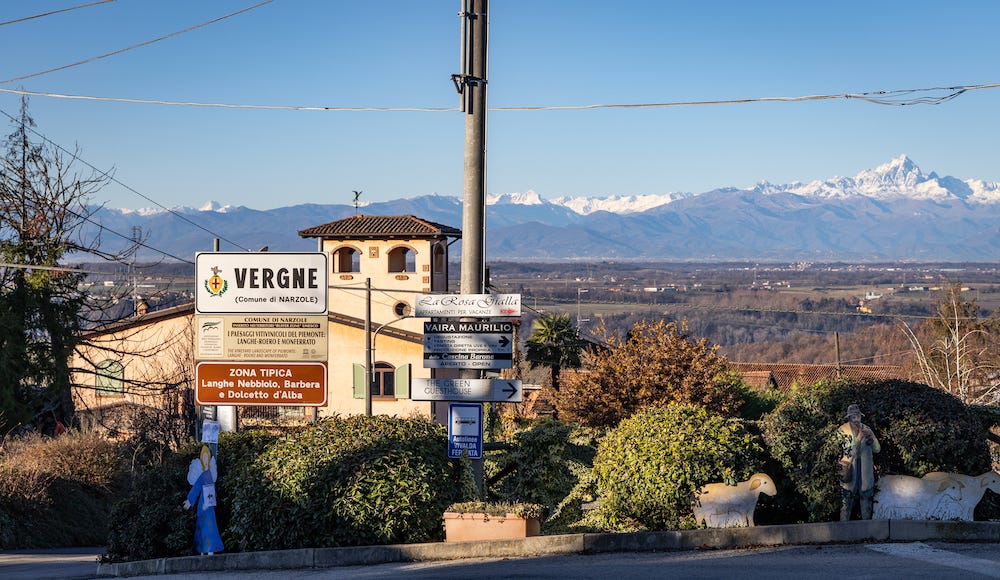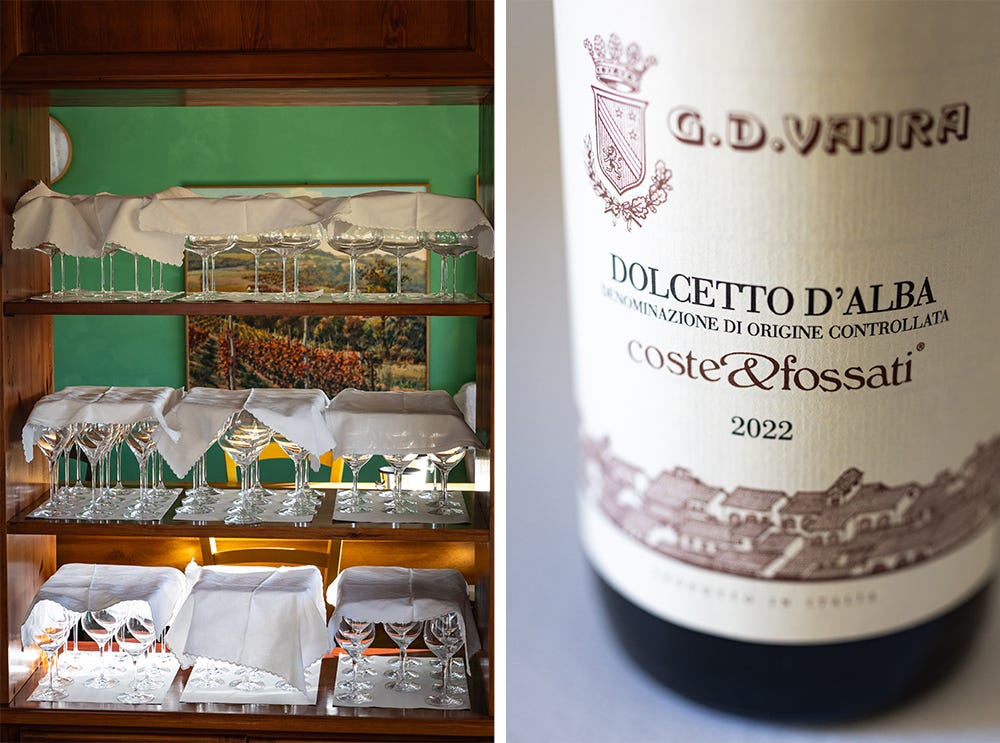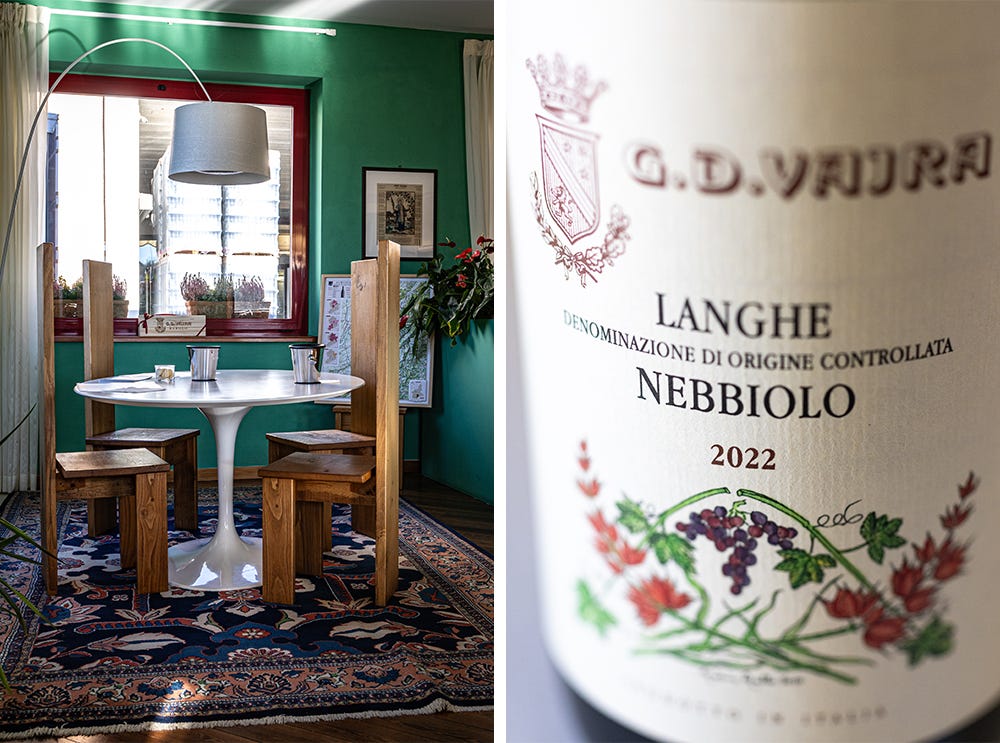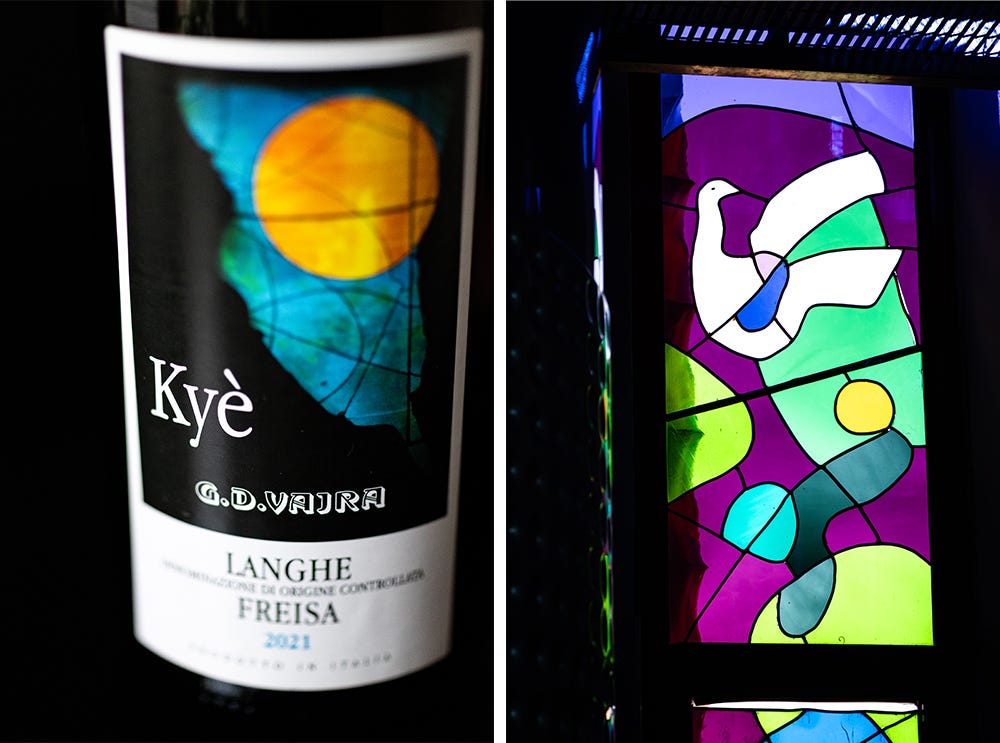Finally! The promised Part Two, that explores why we went to Piedmont: Barolo. The iconic Italian wine made with the Nebbiolo grape and enjoyed at its fullest expression with age. Here’s the tasting that contextualised Barolo – and introduced its extended family. To set the scene, click here to read Part One.
‘You need to know,’ said Natascia Fanni, as she started uncorking the bottles, ‘that 30, 40 years ago it was normal to come to Piemonte just to buy Dolcetto. And to say “grazie mille” for your visit? You would be given a bottle of Barolo. Now it’s completely the opposite. As you know, Nebbiolo and Barolo are more famous than Dolcetto.’
Barolo’s fame, was exactly why we were sitting in this particular tasting room, surrounded by artworks of autumn-coloured vines and polished tasting glasses covered with square cotton cloths. On driving into the tiny hamlet of Vergne to find G.D. Vajra, our anticipation was as bright as the turquoise sky.
Located halfway between the towns Barolo and La Morra, the tasting room at this family-run winery is filled with sections of stone, clear tubes of sand, and raised relief maps that illustrate terroir and a clear love for the surrounding land. Vajra has led with organic principles for over 50 years.
We’re told the Vajra family considers their library of books a cornerstone of their work and fall quiet in wonder at the light entering their cellar as if through a prism. They commissioned a stained-glass window by priest and artist Father Costantino Ruggeri that’s like a visual reminder to seek out life’s beauty.
Natascia was leading the tasting, which would peak with G.D. Vajra’s single-vineyard Barolo Ravera. But first we started building reference points of how tannins and acidity characterise the region’s wine. As if taking us by the hand, Natascia poured the gentlest introduction: Dolcetto. And asked if we knew how it got it’s name.
Dolcetto
‘It’s got nothing to do with “Dolce”, meaning sweet or sweetness,’ says Natascia, as we take our first sip, ‘but the name comes from our dialect. In Italian the bumps on the street are “Dosso”, in the Piedmontese dialect the “Ducette”.’
‘This wine has tannins and also acidity, but not like the acidity of the Barbera or the tannins of the Nebbiolo, the tannins and acidity in the Dolcetto are softer, rounder, smoother, like a Ducette, like a Dolcetto.’
‘I like to call Dolcetto the Beaujolais from Langhe: easy, juicy, fresh – a slice of salami, a piece of cheese are good friends and it’s really a wine that encourages conviviality.’ That said, the Dolcetto we’re tasting is not your average Dolcetto: it has aging potential. But how to achieve that with more moderate tannins?
Tannins are what Nature created to stop animals eating unripe fruit and for humans drinking wine, tannins are what can leave the feeling your mouth has been sucked dry. Ironically they’re also one of the reasons we love red wine, because as the wine matures the tannins soften and create structure.
Taking up the question as a challenge, founder Aldo Vajra applied his mind and ‘recipe-free’ approach. Natascia tells how he noticed a heritage Dolcetto vine with a red stem that had more phenolic concentration, which was exactly what he was looking for. So, he planted it in two of Vajra’s best Barolo vineyards.
‘On the east side, they give us more acidity, and on the south, the opposite, concentration,’ continues Natascia. ‘So with every vintage we can make a beautifully balanced wine because we can choose the quantity of each. We pick at different times with different vinifications, and blend just before bottling.’
‘It’s a Dolcetto with a little bit of extra acidity but it’s also a Dolcetto you can age a few years, even 10 years, no problem.’ concludes Natascia.
Nebbiolo and Barolo
‘If you don’t know the taste of the Nebbiolo grape,’ says Natascia as she pours, ‘you can’t understand the Barolo (which is 100 percent Nebbiolo) and if you don’t taste a good, classic Barolo that helps your palate understand, more generally, what Barolo means, how are you going to fall in love with and tell the difference between the single vineyard Barolos?’
So before we taste Vajra’s single-vineyard Barolo Ravera, Natascia pours the Langhe Nebbiolo to get to know the grape itself and the Barolo Albe to get to know Barolo as a wine, taking care to emphasise: ‘All three wines are important; it’s not about which is best, it’s about the differences between them.’
The Barolo Albe is not to be confused with Alba, the nearby town – Albe means dawns. ‘It’s called d’Albe,’ Natascia clarifies, ‘because the grapes come from three different vineyards, which have three different positions, so they see three different sunrises.’
‘As you know, with Barolo you walk into the cellar and you’re almost too scared to open it,’ says Natascia, ‘not today because it’s too young, not tomorrow because is not the perfect day, we need to find a special occasion.’
‘With our single vineyard Barolo, we always say it will be fantastic in a few years. So, I’m not saying you don’t need to age Barolo, but what we do want to say is, there are wines you can drink in the meantime, while you are waiting for others. A good glass, right now.’ That is the Barolo Albe.
After giving us a chance to taste and reflect, Natascia shares her sensory experience of tannin and acidity in all three wines: the Langhe Nebbiolo, the Barolo Albe and the Barolo Ravera. ‘It’s always incredible, the ballet the wines create in your mouth, especially the tannins, because it really changes what you feel.’
‘For me the Nebbiolo, the tannins are almost softer. With the Barolo Albe it’s like a warmup because it comes from three vineyards, the tannins have a good balance.’ Her ballet analogy is en pointe. There’s a thread that runs through all Vajra’s wines: a kind of athleticisim meets grace, like a prima ballerina who is able to hold a movement but make it appear effortless.
‘When you taste the Ravera,’ she says, gaining momentum, ‘it’s bam! Tannins on the front and they’re still there for a few seconds, then it goes onto the back of your tongue, then it arrives at the end of your tongue and that is the moment you start feeling the acidity and, in a second, your mouth starts watering and [she whistles] it starts again on the front, removing the tannins with a super long balsamic finish.’
‘But then, ah, I sense the Ravera soil – this is why it’s a little bit rustic, why it has more wild notes,’ says Natascia, bringing us to how the soil types are a key influence on the nature of each single-vineyard Barolo and explaining: ‘The Barolo region has 11 communes in total and 186 crus. The soils are totally different. You need to imagine the Langhe in layers because all the soils here are from sedimentation. Imagine, more than 15 million years ago, the sea was here!’
And coming back to what’s in the glass, Natascia says in a winking tone: ‘Ravera we like to call the lasagne soil.’ This unofficial term describes the layering of white silicates and red iron that, together with the amphitheatre-like contours of the land, and vines roughly 50 years old, offers up a deep, textured Barolo.
Freisa
As we’re about to leave, Natascia hands us a bottle of Freisa to take home. It’s the long-lost family member we never tasted as part of the line-up. She explains it’s an important grape for Piedmont but unlike Barolo, which is tightly regulated in terms of vinification, Freisa is not.
‘Remember, when you see Freisa on a winelist, ask always the sommelier: What kind of Freisa are we talking about? It can be fizzy, it can be still, it can be aged just in steel tanks or in wood. We make a bone-dry Freisa,’ she says, referring to Vajra’s.
In 2004 researchers looking into the DNA composition of Nebbiolo found Freisa to be a close relative. And those in the know would understand the layered meaning of Vajra’s Freisa label.
While most of their bottle labels bear delicate etchings by the artist Gianni Gallo, two are designed by Father Costantino Ruggeri, creator of the stained-glass window that casts colour over Vajra’s steel tanks.
Those labels are the Albe (Barolo), featuring overlapping red and yellow circles to symbolise the sun, and the Kyè (Freisa), which features a golden orb as a prompt: is it the sun or is it the moon? Natasha then explains the word play behind the name.
‘If I cover the label with my hands,’ she says, ‘And you say the name of the wine, say it in Italian and Cyè starts with a C and is the Italian for “who is”, but spell it in this way [with a K] and the phonetic part is the same: Cyè, Kyè, but the meaning is different.’
‘In our dialect, it means “it’s me”. So, who is it? Is it the moon or is it the sun? Is it the Freisa or is it the Nebbiolo? It’s me! It’s Freisa. It’s the perfect name for a wine with a fantastic personality.’
A happy surprise that emerged after our visit is if you live in South Africa and would like to taste these varieties, you can find Vajra wines here.
Full disclosure: the tasting (€25 each) was complimentary and although we purchased wine, the bottle of Kyè was a gift.











